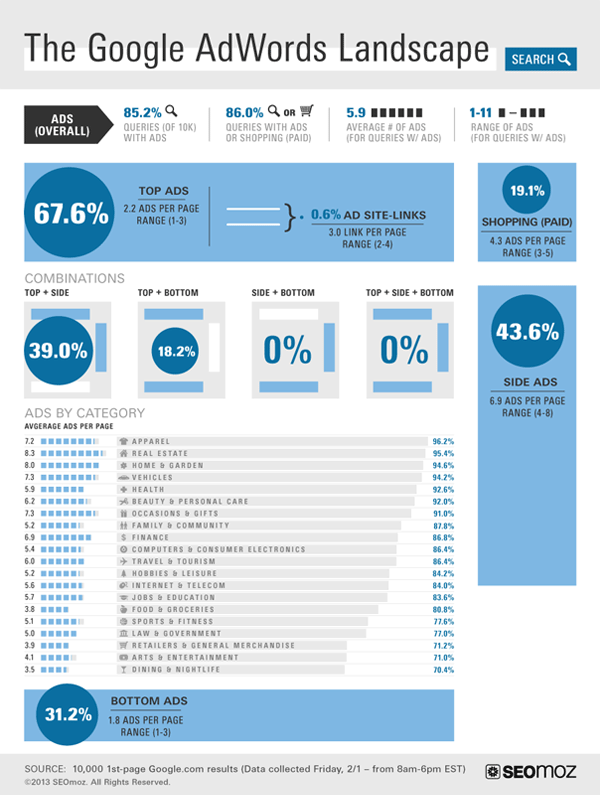
The Google AdWords Landscape (Infographic)
We tend to think of AdWords as the domain of PPC specialists, but it’s becoming clearer and clearer that Google’s SERP advertising has a huge impact on the position and effectiveness of organic results. So, I wanted to ask a simple question – what does the AdWords “landscape” actually look like in 2013? In other words, where are the ads, how many are there, what combinations occur in the “wild”, and how often do they show up? I’ll dive into some details below, but the answer looks something like this (click the image for a full-sized view)…
Embed this image:
The Methodology
We collected data from 10,000 page-one Google SERPs via Google.com on a weekday during normal business hours. Personalization was turned off, and the crawler emulated a logged-out Chrome browser. We parsed the major ad blocks (which have consistent DOM markers) and the links within those blocks. Keywords and categories were pulled from AdWords’ keyword tools, with 500 keywords coming from each of 20 categories.
A Few Caveats
Naturally, keywords pulled from the AdWords’ research tools are more likely to have commercial intent than the “average” keyword (if such a thing exists), so these percentages may not be indicative of the entire world of search queries. We did run these numbers at other time periods and on other days, and the results were fairly consistent.
These statistics were computed by unique queries, not by query volume. The results seem to be very similar, though. For example, we found ads on 85.2% of the queries crawled – if we weight those queries by Google’s “global” volume, we get ad penetration of 84.5%. The correlation between the presence of ads and query volume was virtually non-existent (r=-0.018). The correlation between the presence of ads and Google’s competition metric was high (r=0.874). This is probably not surprising, since “competition” is essentially defined by how many advertisers are vying for any given query.
The Changing Landscape
This is only a snapshot of a rapidly changing picture. For example, paid shopping results are still relatively new, but we discovered them on almost 20% of the queries we crawled. Unlike the traditional AdWords blocks, paid shopping can appear in multiple positions and forms, including the larger, upper-right format previously reserved for Knowledge Graph.
Even traditional top ads are evolving, with ads showing extensions, expanded site-links, lead generation forms, etc. Expect Google to experiment with new formats on the top and right, and to blend advertising into the Knowledge Graph area to increase CTR. This changing landscape will impact the efforts of people in both paid and organic search, so keep your eyes open, and don’t assume that this is something only the PPC team has to worry about.
I just wanted to thank Dawn Shepard for all her help putting together the infographic. I know it was probably a bit painful to hear "Make it kind of boring!" ;)





Comments
Please keep your comments TAGFEE by following the community etiquette
Comments are closed. Got a burning question? Head to our Q&A section to start a new conversation.